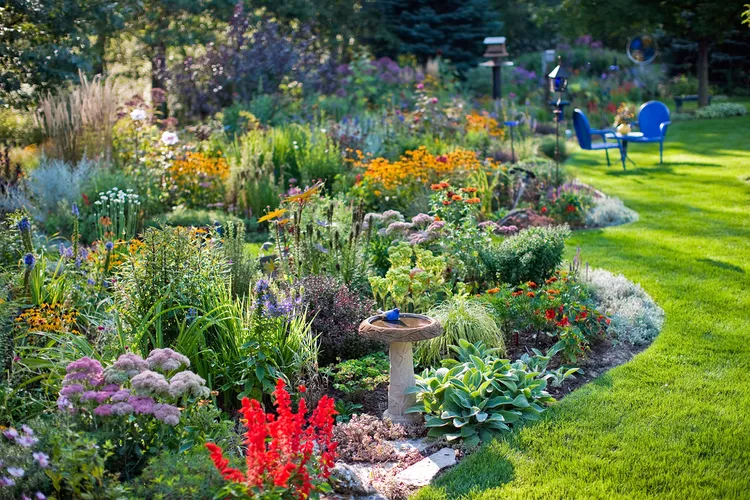Part of the beauty of any landscape is the fascinating wildlife that lives in it, including beautiful songbirds. Wrens, cardinals, swallows, nuthatches, and more will fill your garden with their sweet songs if you provide them with a few of their favorite native plants and some water for bathing or drinking.
You don't need to follow all of these tips to make your winged visitors happy; choose which ones will work best for your landscape (you might already be doing some of them), and soon your garden will become an amazing bird-watching destination.
1. Plant a Diverse Landscape
Attracting songbirds to the garden means creating a solidly packed, multi-layer landscape that has a variety of plants to supply structure and food throughout the year. When designing and planting beds and borders, think both horizontally and vertically. Include annuals, perennials, herbs, vegetables, and grasses.
2. Choose the Best Foods for Birds and Butterflies
To draw birds in, find a seed or food specific to the birds you want to attract. In addition, you'll draw a more interesting variety of birds than you would with a general wild bird food. For starters, try an assortment of seed- or nectar-producing plant species known to please songbird palates, including black-eyed Susan, coneflower, coreopsis, and salvia. Or fill bird feeders with sunflower seeds, which are good for attracting songbirds to the garden (and a favorite of most seed-eating birds).
Suet and mealworms attract insect-eating birds such as nuthatches and woodpeckers; cracked corn draws pigeons and doves. For goldfinches, indigo buntings, and towhees, include a finch mix; finches also love nyjer seeds. A general songbird seed blend draws cardinals, titmice, blue jays, and white-throated sparrows, among others, while safflower attracts songbirds but isn't as attractive to greedy squirrels, starlings, and grackles. Hummingbirds visit feeders with sugar and water, as do orioles, house finches, and red-bellied woodpeckers; you can also set out fresh fruit halves for orioles, tanagers, and grosbeaks.
3. Replace Non-native Plants with More Nutritious Natives
To attract songbirds to the garden, native plants provide a balanced diet of seeds and fruits that ripen at critical times. The more natives you plant, the more insects you draw, and the more varieties of songbirds will visit.
4. Include a Birdbath
Birds love to splash in water, so including a birdbath is a good method for attracting birds to your yard. Place the birdbath in an open location so the birds can keep an eye on their surroundings and watch for potential predators; change the water every few days.
5. Include Trees and Shrubs in Your Wildlife Garden
Trees and shrubs provide shelter from storms and hiding places from predators. Plus, trees and shrubs supply a spot for birds to build a nest, which is how to attract songbirds to the garden. Trees that bear fruits and nuts, such as flowering crabapple, also offer food to many songbirds. Include several specimens for as much variety as possible. Include at least one thorny species, such as hawthorn or rose, to provide protective perches.
A few dense evergreens (juniper, spruce, yew) offer winter cover; a variety of berry-producing species such as dogwood, serviceberry, chokeberry, and viburnum provide fruit at different times in the season. Bonus: Many trees are also attractive to butterflies.
6. Reduce the Size of Your Lawn
A yard with fewer square feet devoted to turf and more space with wildlife-attracting plants will naturally have more songbirds. For native grasses, good choices for attracting songbirds to the garden include switchgrass and little bluestem; cut them back yearly in early spring.
7. Leave Stems Standing this Winter
Instead of cutting perennials to the ground in autumn, leave stems to help shelter overwintering insects that songbirds may eat. You can also leave brush piles from cleanup chores. These fallen branches are a great ground-level shelter for birds.
Test Garden Tip: Leaving brush piles may attract and provide habitat for other wildlife, such as rodents so make sure to site them away from your house.
8. Maintain Bird Feeders and Birdhouses
Feeders and birdhouses are easy ways to attract songbirds to the garden, but you must keep them in good shape. Clean out and repair boxes in late winter before nesting season begins. Clean feeders weekly to keep them free of disease-causing bacteria. This is especially important for hummingbird feeders. Empty feeders, then soak them in a solution of 1 part bleach to 9 parts water. Rinse off well in warm water and allow to dry before refilling.
9. Avoid Herbicides, Pesticides, and Fertilizers
Any of these substances can be deadly to birds and other wildlife. A better bet to attracting songbirds to the garden is to rely on biological controls for insect pests and keep weeds down by pulling them when they are small and before they have a chance to go to seed.
10. Keep Cats Indoors
Your felines may want to roam, but cats cause the death of millions of songbirds each year. Your best bet for attracting songbirds to the garden is to separate the two.




















